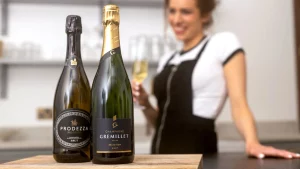Prosecco is a sparkling wine that is becoming increasingly popular around the world. But is prosecco champagne? While both Prosecco and Champagne are sparkling wines, they are produced in different regions and using different methods. So, let us find out more about the question below.
No, Prosecco is not champagne. While both Prosecco and Champagne are sparkling wines, they are produced in different regions and using different methods. Champagne is made in the Champagne region of France, while Prosecco is made in the Veneto region of Italy.
Champagne is made using the traditional method, while Prosecco is made using the Charmat method. Additionally, Champagne can only be produced with specific grape varietals, while Prosecco can be produced with a variety of grape varietals. Therefore, the taste and production process is different for Prosecco and Champagne.
Overview of Prosecco and Champagne
Prosecco and Champagne are both sparkling wines, but they are produced in different regions and using different methods.
Prosecco is made in the Veneto region of Italy, primarily using Glera grapes. It is produced using the Charmat method, which involves fermenting the wine in stainless steel tanks before bottling it with a second fermentation. This method is known for producing wines that are fresher and fruitier in taste. Prosecco is usually less expensive than Champagne and is often consumed as an aperitif or with light meals.
Champagne, on the other hand, is made in the Champagne region of France, primarily using Chardonnay, Pinot Noir, and Pinot Meunier grapes. It is produced using the traditional method, also known as the method of champenoise, which involves fermenting the wine in the bottle with a second fermentation.
This method is known for producing wines that are more complex, with a greater depth of flavor and higher acidity. Champagne is usually more expensive than Prosecco and is often consumed as a celebratory drink or with more formal meals.
In summary, Prosecco and Champagne are both sparkling wines, but they are made in different regions and using different methods, which leads to a different taste and texture; Champagne tends to be more complex and expensive, while Prosecco is fresher and fruitier and less expensive.
Prosecco vs champagne
Prosecco and Champagne are both sparkling wines, but there are several differences between the two.
Similarities:
- Both are made using the traditional method of secondary fermentation in the bottle, which creates the bubbles.
- Both are made from grapes, although different varieties are used.
Differences:
- Prosecco is made from a grape variety called Glera, primarily in the Veneto region of Italy. Champagne, on the other hand, is made from a blend of three grape varieties (Chardonnay, Pinot Noir, and Pinot Meunier) in the Champagne region of France.
- Prosecco is generally sweeter and less complex than Champagne.
- Prosecco is typically less expensive than Champagne.
- The bubbles in Prosecco are typically smaller and more numerous than those in Champagne.
- Champagne is aged for a longer period of time than Prosecco.
How to properly store and serve Prosecco
Properly storing and serving Prosecco can enhance its flavor and overall quality. Here are some tips on how to do so:
- Store Prosecco in a cool, dark place: Prosecco should be stored in a cool, dark place, ideally between 43-50°F (6-10°C) and away from light. This will help to preserve the wine’s bubbles and prevent it from going flat.
- Keep it upright: It is important to store Prosecco upright to prevent the cork from drying out and letting air into the bottle, which can spoil the wine.
- Chill the wine: Prosecco should be chilled before serving. The ideal serving temperature for Prosecco is between 42-48°F (6-9°C).
- Use the right glass: Prosecco is best served in a flute glass. The narrow shape of the flute concentrates the bubbles and aromas, while the stem allows you to hold the glass without warming the wine.
- Pour gently: When pouring Prosecco, do it gently to avoid spilling or losing bubbles.
- Serve in moderate quantity: Prosecco should be served in moderate quantity, ideally between 4-6 oz (120-180ml) per glass, to enjoy the wine’s characteristics, bubbles, and aromas.
- Enjoy it young: Prosecco is a wine that is best enjoyed young, so it is best to drink it within 1-2 years of the bottling date.
By following these tips, you can ensure that you are properly storing and serving Prosecco, which will enhance its overall quality and enjoyment.
Popular Prosecco brands and their taste profiles
There are many popular Prosecco brands available in the market, each with its own unique taste profile. Here are a few popular brands and their taste profiles:
- Bisol: Bisol is a popular brand of Prosecco known for its crisp, dry style. Their wines have a good balance of acidity and sweetness, with notes of green apple and lemon zest.
- Zonin: Zonin is another popular brand of Prosecco known for its fruity and floral aromas. Their wines have a medium body with a good balance of acidity and sweetness. They tend to have floral notes, particularly acacia and wisteria, and fruity notes, such as apple and peach.
- Mionetto: Mionetto is a well-known brand of Prosecco known for its light and refreshing style. Their wines have a good balance of acidity and sweetness, with notes of green apple and pear.
- La Marca: La Marca is a popular brand of Prosecco known for its crisp and refreshing style. Their wines have a good balance of acidity and sweetness, with notes of honeydew melon and citrus.
- Ruffino: Ruffino is a well-known brand of Prosecco known for its dry and crisp style. Their wines have a good balance of acidity and sweetness, with notes of green apple and lemon zest.
- Bottega: Bottega is a popular brand of Prosecco known for its dry and elegant style. Their wines have a good balance of acidity and sweetness, with notes of green apple, pear, and white flowers.
These are just a few popular Prosecco brands and their taste profiles. It’s worth noting that Prosecco can vary depending on the producer, the grape variety, the region, and the specific vintage, so it’s always good to try different brands and vintages to discover your own preferences.
Best food pairings for Prosecco
Prosecco is a versatile sparkling wine that can be paired with a variety of foods. Here are some of the best food pairings for Prosecco:
- Seafood: Prosecco’s crisp acidity and bubbles make it a great match for seafood dishes such as oysters, shrimp, and sushi. The acidity in the wine helps to cut through the richness of the seafood, and the bubbles help to cleanse the palate.
- Salty snacks: Prosecco pairs well with salty snacks such as olives, almonds, and potato chips. The acidity in the wine helps to balance the saltiness of the snacks, while the bubbles add a refreshing element to the pairing.
- Poultry: Prosecco’s acidity and bubbles make it a great match for poultry dishes such as chicken and turkey. The acidity in the wine helps to cut through the richness of the poultry, while the bubbles add a refreshing element to the pairing.
- Light pasta dishes: Prosecco pairs well with light pasta dishes such as spaghetti with a lemon or butter sauce. The acidity in the wine helps to balance the richness of the pasta, while the bubbles add a refreshing element to the pairing.
- Fried foods: Prosecco’s acidity and bubbles make it a great match for fried foods such as tempura, fried chicken, and french fries. The acidity in the wine helps to cut through the richness of the fried foods, while the bubbles add a refreshing element to the pairing.
- Cheese: Prosecco pairs well with a variety of cheeses, particularly soft and fresh cheese, like goat cheese, brie, and burrata. The acidity in the wine helps to balance the richness of the cheese, while the bubbles add a refreshing element to the pairing.
Above are just a few examples of the best food pairings for Prosecco. Keep in mind that, ultimately, the pairing depends on your own personal taste and preferences, so don’t be afraid to experiment and try different combinations.
How Prosecco is made and the production process
Prosecco is a sparkling wine that is made in the Veneto region of Italy, primarily using Glera grapes. The production process of Prosecco involves several steps, including grape growing, harvesting, fermentation, and bottling.
- Grape growing: Prosecco grapes are grown in the hilly regions of Veneto and Friuli Venezia Giulia. The grapes are grown on steep terraced hillsides, which provide optimal exposure to sunlight and good drainage. The grapes are hand-harvested, typically in September.
- Fermentation: Once the grapes are harvested, they are pressed, and the juice is separated from the skins. The juice is then fermented in stainless steel tanks at cool temperatures to retain the freshness and fruity aromas of the grapes.
- Secondary fermentation: After the initial fermentation, the wine is bottled with a small amount of sugar and yeast. This process, called the Charmat method, creates carbon dioxide, which gives the wine its bubbles. The wine is then stored in pressurized tanks at cool temperatures for several weeks to complete the secondary fermentation.
- Riddling and disgorgement: Once the secondary fermentation is complete, the wine is chilled to near-freezing temperatures to make the sediment settle to the bottom of the bottle. The sediment is then removed through a process called disgorgement, where the neck of the bottle is frozen, and the sediment is removed by pressure.
- Dosage: The wine is then topped off with a small amount of wine and sugar, called dosage, to balance the acidity and sweetness.
- Labeling and bottling: Finally, the wine is labeled and bottled. Prosecco is usually bottled under pressure to maintain its carbonation.
The production process of Prosecco is relatively simple and quick compared to other sparkling wines like Champagne, which is made using the traditional method. This is one of the reasons why Prosecco is less expensive than Champagne.
Difference between Prosecco DOC and Prosecco DOCG
Prosecco DOC (Denominazione di Origine Controllata) and Prosecco DOCG (Denominazione di Origine Controllata e Garantita) are both Italian sparkling wines made from Glera grapes, but there are some key differences between them.
- Production area: Prosecco DOC wines can be produced in a larger area, including the Veneto region and parts of Friuli-Venezia Giulia and Lombardy. Prosecco DOCG wines, on the other hand, can only be produced in a smaller area within the Veneto region, specifically in the hills of Conegliano-Valdobbiadene and the Colli Asolani.
- Production method: Both Prosecco DOC and DOCG are made using the Charmat method, but Prosecco DOCG wines have stricter production regulations. For example, DOCG wines must be aged for a minimum of 15 months, while DOC wines do not have this requirement.
- Taste profile: Prosecco DOCG wines tend to have a higher quality and more complex taste profile, with a greater depth of flavor and higher acidity compared to Prosecco DOC wines.
- Price: Prosecco DOCG wines tend to be more expensive than Prosecco DOC wines due to the additional regulations and higher costs of production in the DOCG area.
Overall, Prosecco DOCG is considered to be the highest quality Prosecco, produced in a specific area, with stricter regulations and aging requirements, resulting in a more complex and higher-quality taste, while Prosecco DOC is a more widely produced wine, with less strict regulations and lower price.
The price range of Prosecco compared to Champagne
Prosecco and Champagne are both sparkling wines, but they have different price ranges.
Prosecco is generally considered to be more affordable than Champagne. The price of a bottle of Prosecco can range from $10 to $30, depending on the brand, region, and vintage. There are many options available at the lower end of the price range, making it a popular choice for everyday celebrations and casual gatherings.
Champagne, on the other hand, tends to be more expensive than Prosecco. The price of a bottle of Champagne can range from $30 to $200 or more, depending on the brand, region, and vintage. Champagne is often seen as a luxury item, often consumed on special occasions or to celebrate significant events.
It’s worth noting that there are some high-end Prosecco that can be more expensive than some basic Champagnes, especially if they are made from high-quality grapes, produced in small quantities, and aged for a long time.
Overall, Prosecco is generally considered to be more affordable than Champagne, and it is a more accessible option for everyday celebrations and casual gatherings, but some high-end Prosecco can be more expensive than some basic Champagnes.
How to spot a good quality Prosecco
Spotting a good quality Prosecco can be challenging, but there are a few things to look for to ensure that you are getting a high-quality wine.
- Look for the DOC or DOCG designation: Wines with the DOC or DOCG designation are subject to strict production regulations and are generally considered to be of higher quality than wines without this designation. Prosecco DOCG is considered to be the highest quality Prosecco, produced in a specific area, with stricter regulations and aging requirements.
- Check the label for the grape variety: Prosecco should be made primarily from Glera grapes. Wines that are labeled as “Prosecco” but don’t list Glera as the primary grape variety may be lower quality.
- Check the alcohol content: A good quality Prosecco should have an alcohol content of between 11-12%. Wines with a higher alcohol content may indicate that the grapes were overripe or that the wine was poorly made.
- Look for a reputable producer: Look for well-known and reputable Prosecco producers, such as Bisol, Zonin, Mionetto, La Marca, Ruffino, and Bottega. These producers have a reputation for producing high-quality wines.
- Examine the appearance: A good quality Prosecco should be clear and bright, with a consistent and fine stream of bubbles. It should also have a good level of acidity, which gives the wine a fresh and lively taste.
- Try before you buy: Try different Proseccos from different producers and regions to get a sense of the variations in taste and quality. Take note of the aroma, taste, and finish, and pay attention to any off-flavors or defects that might indicate poor quality.
- Check the vintage: Prosecco can be made from a single vintage or from a blend of different vintages. A wine from a single vintage is more likely to be of higher quality and more expensive than a non-vintage wine; however, it will also have a shorter shelf life.
- Look for the seal of authenticity: Some Prosecco producers will include a seal of authenticity on their bottles to verify the authenticity of the product. This can be a good indicator of the quality and reliability of the producer.
By following these tips, you can increase your chances of finding a good quality Prosecco. Keep in mind that, ultimately, the best way to find a good Prosecco is to try different options and find the one that best suits your personal taste and preferences.
The best Prosecco for special occasions
When it comes to special occasions, many people prefer to celebrate with a bottle of high-quality Prosecco. Here are a few options for the best Prosecco for special occasions:
- Bisol Jeio Prosecco Brut: This Prosecco is made from 100% Glera grapes and is known for its crisp, dry style and complex flavor profile. It has a good balance of acidity and sweetness, with notes of green apple and lemon zest. It’s a perfect choice for a toast or a celebratory drink.
- Zonin Prosecco di Conegliano Valdobbiadene DOCG: This Prosecco is made in the hills of Conegliano-Valdobbiadene and is considered to be one of the best Prosecco DOCG. It has a fruity and floral aroma, a medium body, and a good balance of acidity and sweetness, making it perfect for special occasions such as weddings and anniversary celebrations.
- Mionetto Prosecco DOC Treviso Brut: This Prosecco is made in the Treviso area of the Veneto region and is known for its light and refreshing style. It has a good balance of acidity and sweetness, with notes of green apple and pear. It’s a perfect choice for a toast or as an aperitif.
The nutritional information of Prosecco
Prosecco is a type of sparkling wine that is typically made from Glera grapes. It is a light-bodied wine with moderate alcohol content.
The nutritional information for a 5-ounce (148 ml) serving of Prosecco is as follows:
- Calories: approximately 80-90
- Carbohydrates: 1-2 grams
- Sugar: 1-2 grams
- Alcohol: 11-12%
It’s worth noting that nutritional values may vary depending on the brand or type of Prosecco. Additionally, if you’re trying to watch your calorie intake, you may want to limit your consumption of Prosecco or any other alcoholic beverage.
The alcohol content of Prosecco compared to Champagne
Prosecco and Champagne are both sparkling wines, but they have different alcohol content.
Prosecco typically has an alcohol content of 11-12%, while Champagne has an alcohol content of 12-13%.
Champagne is also made using a different method, known as the “Methode Champenoise,” and it is produced in the Champagne region of France, while Prosecco is made in Italy using a different method.
It’s worth noting that alcohol content can vary depending on the brand or type of sparkling wine, and it’s always recommended to check the label for specific information.
The environmental impact of Prosecco production
Prosecco production, like any agricultural activity, can have an impact on the environment. Some of the potential environmental impacts of Prosecco production include:
- Water usage: Growing grapes for Prosecco production can require a significant amount of water. In some regions, this can put a strain on local water resources.
- Pesticide and herbicide use: Grapes are often treated with pesticides and herbicides to protect them from pests and diseases. These chemicals can harm the environment if they are not used responsibly.
- Carbon footprint: The production, transportation, and packaging of Prosecco all contribute to its carbon footprint. The amount of carbon emissions can vary depending on the specific production methods used.
- Soil erosion: Intensive vineyard management practices can lead to soil erosion, which can negatively impact the fertility of the land.
However, many Prosecco producers are taking steps to reduce their environmental impact. Some are implementing sustainable farming practices such as reducing pesticide and herbicide use, using renewable energy sources, and investing in carbon offsetting initiatives. Additionally, some producers are using sustainable packaging materials and reducing their transportation emissions.
How to make a classic Prosecco cocktail
A classic Prosecco cocktail is the Bellini. Here is a recipe for making a Bellini cocktail:
Tools:
- Cocktail shaker
- Strainer
- Champagne flute
Ingredients:
- Prosecco
- White peach puree (or peach nectar)
- Ice
Steps:
- Fill the cocktail shaker with ice.
- Add 2 ounces of white peach puree (or peach nectar) to the shaker.
- Shake well to combine the peach puree and ice.
- Strain the mixture into a champagne flute.
- Slowly pour Prosecco over the peach puree mixture, being careful not to let the Prosecco foam too much.
- Stir gently, if desired
- Garnish with a slice of peach, if desired.
- Enjoy.
It’s worth noting that the recipe can be adjusted to personal taste. You can adjust the amount of peach puree or nectar to taste or even use other fruit puree or nectar to make different variations of the cocktail.
Prosecco vs Champagne: Which one is better?
Prosecco and Champagne are both sparkling wines, but they are made using different methods and come from different regions. Prosecco is made in Italy using the Charmat method, which involves fermenting the wine in stainless steel tanks before bottling it.
Champagne, on the other hand, is made in the Champagne region of France using the Methode Champenoise, which involves a secondary fermentation in the bottle.
In addition, prosecco tends to have a more floral and fruity taste, with notes of apple, pear, and peach. It is generally considered to be a lighter-bodied and sweeter wine than Champagne, which is known for its toasty and brioche-like flavors. Champagne also tends to have higher acidity and a more complex flavor profile.
In terms of price, Prosecco is generally considered to be more affordable than Champagne, but this will vary depending on the specific brand and type.
Ultimately, whether Prosecco or Champagne is “better” is a matter of personal preference. It depends on your taste and the occasion you are drinking it for. If you are looking for a light, fruity, and affordable sparkling wine, Prosecco may be a good choice. If you are looking for a more complex, toasty, and elegant sparkling wine, Champagne may be a better fit.
Conclusion
With the information on this page about the question is prosecco champagne, you can get to tell clearly the similarities and differences between the two.
Prosecco is a type of sparkling wine that is made in the Veneto region of Italy, whereas Champagne is a sparkling wine that is made in the Champagne region of France. Both Prosecco and Champagne are made using the traditional method of secondary fermentation in the bottle, but they use different grape varieties and have different production methods.




